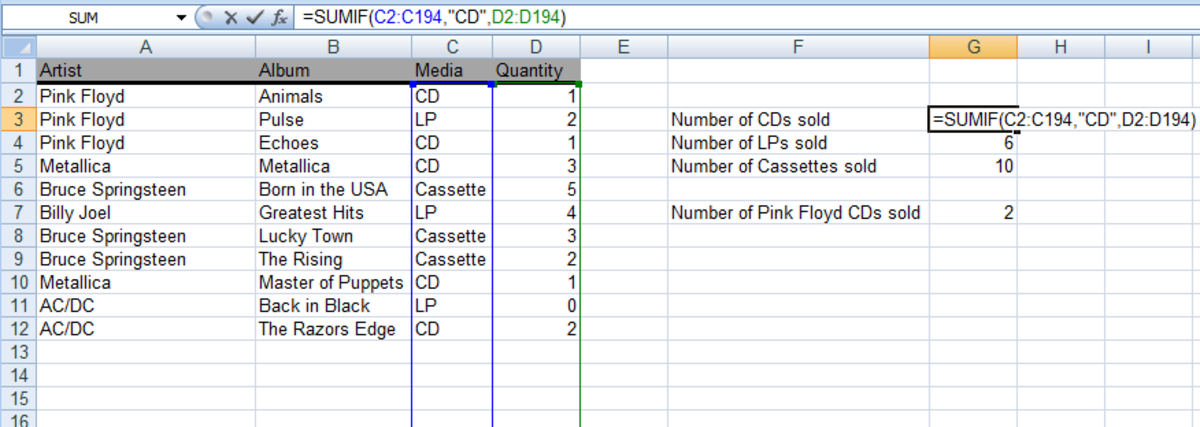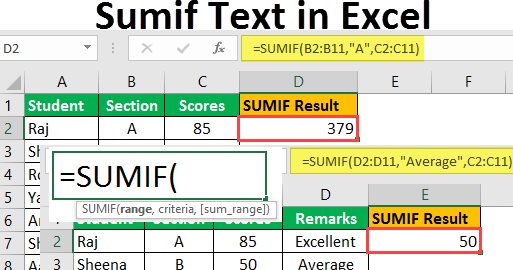A Biased View of How To Use Sumif
You make use of the SUMIF function to sum the values in a range that satisfy standards that you specify. For instance, suppose that in a column which contains numbers, you intend to sum just the worths that are bigger than 5. You can use the complying with formula: =SUMIF(B 2: B 25,"> 5") This video is part of a training program called Add numbers in Excel.

For instance, the formula =SUMIF(B 2: B 5, "John", C 2: C 5) sums just the values in the range C 2: C 5, where the matching cells in the variety B 2: B 5 equivalent "John." To amount cells based on numerous standards, see SUMIFS feature. SUMIF(variety, requirements, [sum_range] The SUMIF feature phrase structure has the following disagreements: array Required.
Cells in each range must be numbers or names, ranges, or referrals that consist of numbers. Blank as well as message worths are neglected. The picked array might include dates in standard Excel format (instances below). requirements Needed. The requirements in the form of a number, expression, a cell referral, message, or a function that specifies which cells will be included.
Crucial: Any kind of text standards or any type of criteria that includes rational or mathematical signs need to be enclosed in dual quote marks ("). If the requirements is numerical, dual quotation marks are not needed. sum_range Optional. The actual cells to add, if you intend to add cells apart from those defined in the variety argument.
The Best Guide To Sumif Not Blank
You can make use of the wildcard characters-- the enigma (?) and also asterisk (*)-- as the requirements disagreement. A concern mark matches any type of solitary personality; an asterisk matches any type of series of personalities. If you intend to locate a real question mark or asterisk, type a tilde (~) coming before the personality. The SUMIF function returns incorrect outcomes when you use it to match strings longer than 255 personalities or to the string #VALUE!.

The real cells that are added are figured out by utilizing the top leftmost cell in the sum_range debate as the start cell, and after that including cells that match in dimension and also form to the array debate. For instance: If variety is And sum_range is Then the actual cells are A 1: A 5 B 1: B 5 B 1: B 5 A 1: A 5 B 1: B 3 B 1: B 5 A 1: B 4 C 1:D 4 C 1:D 4 A 1: B 4 C 1: C 2 C 1:D 4 Nonetheless, when the array and sum_range disagreements in the SUMIF feature do not include the exact same number of cells, worksheet recalculation may take longer than anticipated.
For solutions to show results, choose them, press F 2, and after that press Enter. If you need to, you can readjust the column sizes to see all the information. Residential Or Commercial Property Worth Compensation Information $100,000 $7,000 $250,000 $200,000 $14,000 $300,000 $21,000 $400,000 $28,000 Solution Description Result =SUMIF(A 2: A 5,"> 160000", B 2: B 5) Sum of the payments for property values over $160,000.
$900,000 =SUMIF(A 2: A 5,300000, B 2: B 5) Sum of the commissions for residential property worths equivalent to $300,000. $21,000 =SUMIF(A 2: A 5,">" & C 2, B 2: B 5) Sum of the commissions for residential or commercial property values higher than the value in C 2. $49,000 Instance 2 Replicate the example information in the following table, and also paste it in cell A 1 of a brand-new Excel worksheet.
The Ultimate Guide To Sumif Date Range
If you require to, you can change the column widths to see all the data. Category Food Sales Vegetables Tomatoes $2,300 Veggies Celery $5,500 Fruits Oranges $800 Butter $400 Veggies Carrots $4,200 Fruits Apples $1,200 Solution Description Result =SUMIF(A 2: A 7,"Fruits", C 2: C 7) Amount of the sales of all foods in the "Fruits" group.

$12,000 =SUMIF(B 2: B 7,"* es", C 2: C 7) Sum of the sales of all foods that end in "es" (Tomatoes, Oranges, as well as Apples). $4,300 =SUMIF(A 2: A 7,"", C 2: C 7) Sum of the sales of all foods that do not have a classification specified. $400 Top of Web page You can constantly ask a professional in the Excel User Voice.
To sum if cells contain particular text, you can make use of the SUMIF function with a wildcard. In the instance revealed, cell G 6 has this formula: =SUMIF(C 5: C 11,"* tee *", D 5:D 11) This formula sums the quantities in ... To subtotal data by team or tag, directly in a table, you can use a formula based upon the SUMIF function.

To sum if better than, you can use the SUMIF function. In the example shown, cell H 6 includes this formula: =SUMIF(amount,"> 1000") where "quantity" is a named range for cells D 5:D 11. This formula sums ... To make it possible for a dropdown with an "all" option you can make use of data recognition for the dropdown listing, as well as a formula based on IF, AMOUNT, and also SUMIF functions to calculate a conditional amount.
Some Ideas on Sumif Multiple Criteria You Should Know
To sum if cells finish with specific text, you can use the SUMIF feature. In the example revealed, cell G 6 contains this formula: =SUMIF(product,"* hat", quantity) This formula sums cells in the named variety amount (D 5: ... If you require to subtotal numbers by shade, you can easily do so with the SUMIF function.
To sum if cells contain details text in another cell, you can make use of the SUMIF feature with a wildcard and also concatenation. In the example shown, cell G 6 contains this formula: =SUMIF(C 5: C 11,"*"& F 6 & ... To sum numbers based upon other cells being equal to either one worth or another (either x or y), you can make use of the SUMIF feature.
The ... To conditionally sum similar arrays that exist in separate worksheets, all in one formula, you can do so with the SUMIF function + INDIRECT, wrapped in SUMPRODUCT. In the example, the formula resembles this: =... If you need to sum values when cells are equivalent to one of many points, you can utilize a formula based on the SUMIF and SUMPRODUCT features.
excel sumif today excel sumif vs sumproduct sumif excel based on date